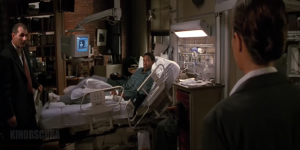18
Exposing Ableism and Patriarchy in The Bone Collector
By Wilson Greya
Historically, people with disabilities have been labeled, sorted, and arrayed on scales according to their deviation from standardized norms in what is called a medical model. In the early 1800s and 1900s, people with congenital impairments or so-called “with anomalies” were exhibited as traveling “sideshows” and ”freak shows” where people who were so-called “normal” were invited to laugh or feel pity for them. These stereotypes shaped the early Hollywood films’ stories like “ Fake Beggar (1898) and Two Ladies and a Beggar (1909) in which their plots reflected disabled people with negativity (Benson & Griffin). Although American Hollywood has been dominated by white patriarchal ideologies that associate disability with negativity, the 1999 movie The Bone Collector moves past these stereotypes to present a black man in the lead role and a storyline that exposes the problems with patriarchy. This essay aims at analyzing films’ representation about disability from ableist to power, difference, and class perspectives with respect to this film which is about a disabled detective and unexperienced policewoman officer working closely together to track down a notorious serial killer who was leaving behind bones and other clues of his victims at the crime scenes to test the police investigative skills.
Foremost, the main character of the film The Bone Collector (1999), Detective Lincoln Rhyme (Denzel Washington), is an able-bodied black man. However, the film plot demonstrates the shift in cultural belief and stereotypes discriminations towards people with disabilities, women, or black actors (initially Hollywood films used consumes for a white person to look like a black person in roles that required a black person). According to Anne, E Kaplan, the author of Women, and Film: Both Sides of the Camera, classic Hollywood films portray women in situations where women have no voice, no discourse, no place from which to speak. In this context, the films also exposed the patriarchal ideologies which take place in working environments where men who may mostly be in leadership positions look down on women as demonstrated in a scene where Police Captain Howard, treated Amelia Donaghy (Angelina Jolie) as unfit for the detective work despite taking an effort to stop a train (Figure 1) to preserve a crime scene even though she was not trained for forensics. From the film, Captain Howard is heard saying arrogantly “So you’re the one who stopped the train….Patrolman, Donaghy mmm pretty dumb”.

In his book Disability Rhetoric, English professor Jay Timothy Dolmage explains that the social model of disability was much-appreciated post World War II when wounded or disabled soldiers came back to their countries where they were also needed most to rebuild post-war economies. This resulted in the boost of prosthetics and other technologies that allowed and encouraged wounded or veterans to work. Dr. Dolmage also argues that the development of text messages, emails, faxes, and other electronics which are currently important aspects of everyday life were first developed to make the working environment conducive for people with disabilities which is the social model of disabilities. In this film, Detective Lincoln Rhyme is seen using a state-of-art computerized system in Figure 2 that allows him to interact with his team working on serial killer cases. Likewise, he is seen making phone calls using voice commands and freely adjusting his posture using a mechanized bed. This demonstrated the shift in the medical model with negativity towards the people with disabilities.

Similarly, the film the Bone Collector (1999) demonstrates how power is usually expressed within different social classes. For instance, Captain Howard at the crime scene coercive Officer Amelia Donaghy by instructing her to hand over all evidence to the forensic team as she was not a detective officer. In this scene, the editing technique shows Officer Amelia Donaghy frozen, speechless, and disgraced, she expected something like “Thank you! officer”, but instead her job was threatened. Thus, it is common in working places where team leaders can inflict fear of losing the jobs or punishing subordinates explicitly or implicitly.
In another scene, Officer Amelia Donaghy was not interested in being on the team to track down the serial killer, and when she told Detective Lincoln Rhyme that he cannot make her join, the other man who was superior to her said “ Yes, but I can”. In these contexts, the power exercised by captain Howard was unnecessary because was just so arrogant as demonstrated with his facial expressions in that scene picture. On the other hand, I agree with the power exercised by another superior to Officer Amelia Donaghy being on the team because Detective Lincoln Rhyme showed respect and appreciation for the work, she did take photographs using her resources, the evidence which was an integral part of in finding the killer.
While the film The Bone Collector aimed at defying the odds against discrimination of people with disabilities, it can also arguably that is indirectly discriminative. As pointed out that Denzel Washington (Detective Lincoln Rhyme) is not disabled, and one would argue that it favored the abled person over the disabled in this role. However, plot or cinematography can be viewed as about the acquired disabilities like what happens to soldiers wounded at war because, at the beginning of the film, Detective Lincoln Rhyme was seen at the crime scene being hit by a heavy falling metal beam which made rumbling sound falling from above. From this angle, I agree with the way the film was represented on the screen about the social model of disability. However, it would have well-represented people with congenital disabilities the role of Detective Lincoln Rhyme was performed by the person who is disabled.
In summary, The Bone Collector (1999) film follows the classical model of films with their stories having: Beginning, Intermission, and Ending, which is mostly a happy ending as noted in the end Detective Lincoln Rhyme married Officer Amelia Donaghy. Thus, key aspects like genre, choice of stars, producers, and directors play important roles in the marketing and selling of classic films, and this becomes a complicated issue when the public expects to see certain actors or desire certain genres of films as opposed to others. In this context, the actors like Denzel Washington and Angelina Jolie who are already well known to people may tend to be more popular and may reduce the chances of emerging actors who may be disabled to land a role in Hollywood classic films.
Therefore, I feel Hollywood films still practice ableism to a certain extent with respect to this film because even though it breaks the social classes about races and gender issues wherein most movies it had been the abled-male white person in the central role of Hollywood movies excluding black, disabled, and women actors, respectively, the choice of a person who is abled inadequately represented the inclusion of people with disabilities in films or society. However, it cannot be overemphasized, perhaps the film owners could not find someone qualified who was disabled for the role or other reasons like production cost. Whatever transpired the owners or producers can be regarded as an area of further analysis but the baseline, this film demonstrates the shift of change from the clinical model of disability to the social model not just in the films but also in society because the films have more influence on culture.
REFERENCES
Bateman, John and Karl-Heinrich Schmidt. Multimodal Film Analysis: How Films Mean. New York: Taylor and Francis Group, 2011. ProQuest Ebook Central, https://ebookcentral.proquest.com/lib/linnbenton-ebooks/detail.action?docID=957662.
Benshoff, H.M., and S. Griffin. America on Film: Representing Race, Class, Gender and Sexuality at the Movies. 3rd Edition. Hoboken: Willey and Blackwell, 2021.
Bernardi, Daniel. Classic Hollywood, Classic Whiteness. Saint Paul: University of Minnesota Press, 2001. ProQuest Ebook Central, https://ebookcentral.proquest.com/lib/linnbenton-ebooks/detail.action?docID=310550.
Dolmage, Timothy. Disability Rhetoric. Syracuse: Syracuse University Press, 2014. ProQuest Ebook Central, https://ebookcentral.proquest.com/lib/linnbenton-ebooks/detail.action?docID=3410157
Kaplan, Anne, E. Women, and Film: Both Sides of the Camera. New York: Taylor and Francis Group, 1990. ProQuest Ebook Central, https://ebookcentral.proquest.com/lib/linnbenton-ebooks/detail.action?docID=3060342
Rotten Tomatoes. Rotten Tomatoes. 2021. November 2021. https://www.rottentomatoes.com/
Safran, Stephen. “Disability Portrayal in Film: reflecting the Past, Directing the Future.” Exceptional Children 64 (1998): 227-238. https://www.researchgate.net/publication/269094007_Disability_Portrayal_in_Film_Reflecting_the_Past_Directing_the_Future/.

